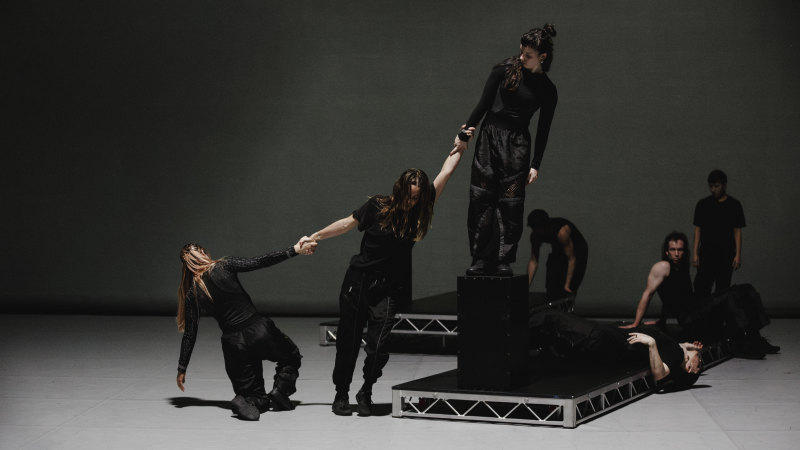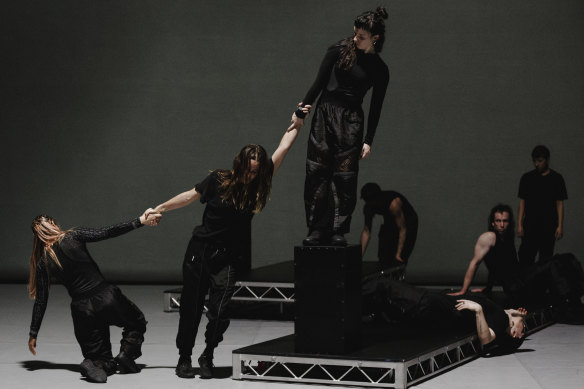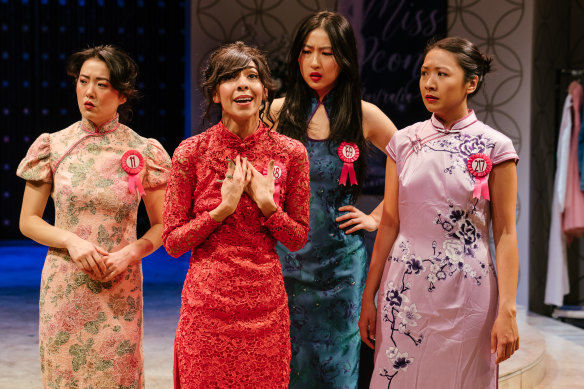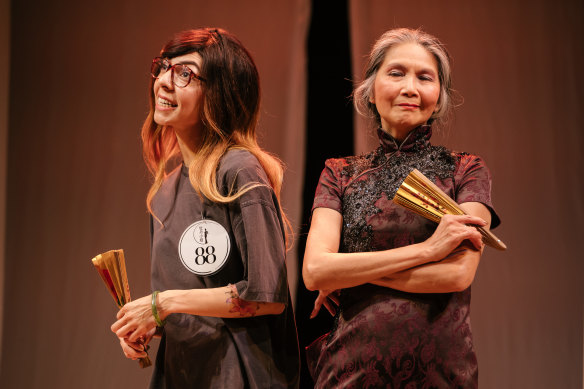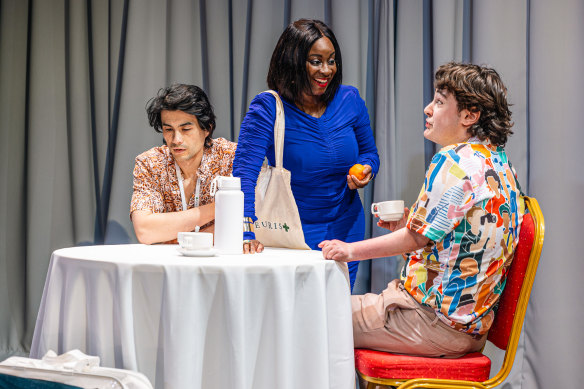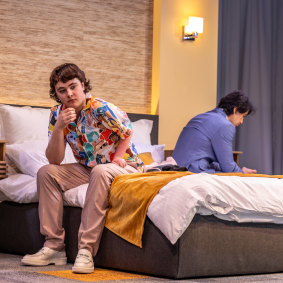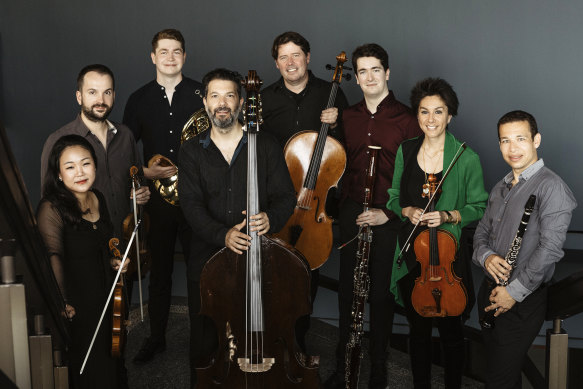Save articles for later
Add articles to your saved list and come back to them any time.
This wrap of shows around Melbourne includes Chunky Move’s 4/4, a modern-day culture clash in Michelle Law’s Miss Peony, Alistair Baldwin’s dark and humorous Telethon Kid, and Musicians of the Gewandhaus Orchestra at Melbourne Recital Centre.
DANCE
4/4, Chunky Move ★★★★
Malthouse Theatre, until August 12
Welcome to the winter of Antony Hamilton’s discontent. The latest evening-length production by Chunky Move’s artistic director is an austere meditation in black, white and grey, reflecting on time and its inexorable passing.
Chunky Move’s 4/4 is an austere, orderly meditation on the passing of time.Credit: Gianna Rizzo
Of course, the work does nothing so banal as making a direct statement on this theme. This is a resolutely abstract piece: orderly, mechanical and very complex in its treatment of the patterned interactions between performers.
The title references four-four time, as well as the organisation of the ensemble. It begins with eight dancers in black, performing in two groups of two pairs. Street dance-influenced phrases are deftly co-ordinated as the pairs move in an out of intricate unison formations.
The sound design, created by Alisdair Macindoe, is a sparse assortment of clicks and ticks and weird pops, which nonetheless keeps the tempo regular, like a metronome, locking the ensemble into a relentless trudging progress.
The pace is unvaried, but the show is far from monotonous. The fascination lies not only with the intricacy and technical refinement of the choreography, but also the strangely deadpan handling of the breakdance material.
Four low platforms on castors are used to create evocative images: the spinning arm of a clock, for example, or two black ships on a white sea voyaging toward oblivion, or a funeral service in a George Miller-style dystopia.
The performers resemble puppets, robots and replicant breakers, connecting with collective nightmares about dancing life-like dolls. And always there is the beat – its unperturbed pace – hurrying the dancing machines into the darkness.
The fine ensemble includes Mason Kelly, Melissa Pham, David Prakash, Harrison Ritchie-Jones, Aimee Schollum, Michaela Tancheff, Nikki Tarling and Jayden Wall. Bosco Shaw has created the lighting design and Paula Levis the costumes.
In large-scale works like Nyx (2015), Token Armies (2019) and Yung Lung (2022), Hamilton has experimented with unusual venues, lavish designs and elaborate multimedia and non-dance elements – all with mixed results.
The simplicity of the presentation in this new piece suggests a renewed enthusiasm for the job of organising bodies in space. It has energy, focus, and you should see it because it stimulates the nervous system like no other sort of contemporary dance.
Reviewed by Andrew Fuhrmann
THEATRE
Miss Peony ★★★½
Fairfax Studio, Arts Centre Melbourne, Until August 20
What does it mean to be Chinese? The “twenty-six, friendless, unmarried” Lily (Stephanie Jack) struggles to know, but the ghost of her recently deceased Poh Poh (Gabrielle Chan, who delivers a star turn as Lily’s ethereal, imposing grandma) has an idea: Lily has to enter Chinese community beauty pageant Miss Peony (that Poh Poh pioneered) and win it.
Enter Lily’s three competitors: filial Shanghainese businesswoman Marcy (Deborah Faye Lee); eccentric Joy (Shirong Wu) from Taiwan; and western Sydney born-and-bred Sabrina (crowd favourite Mabel Li), whose accent is harnessed to great comedic effect.
Guided by pageant producer Zhen Hua (played by Jeffrey Liu), the group is evenly split between ABCs (Australian-born Chinese) and migrants – the play expertly explores the dualities of the former, the regional specificities of the latter, and the nexus of sexism, racism and homophobia.
Miss Peony is at Fairfax Studio, Arts Centre Melbourne, until August 20.Credit: Jason Lau
Marcy, Joy and Sabrina come to life superbly over the course of the play, acquiring depth, dimension and nuance as their personal histories and foibles come to the fore. In comparison, Lily feels underdeveloped – while there’s a strong, necessary ambivalence at the heart of a character who’s parsing her identity, she often feels like a vessel for the broader themes at play rather than a fully developed character in her own right.
The characters switch seamlessly between English, Cantonese and Mandarin, amplifying the polyphonic feel of the play. Every word is subtitled on a screen perched aloft the stage.
The inherently entertaining beauty pageant framework lends the play a natural dramatic tension. Despite this, the play’s pacing is off-kilter at times and there’s lengthy, at times unnecessary, exposition.
Jonathan Hindmarsh’s sparse set – a raised marble stage surrounded by steps – is simple yet effective, transformed into a hospital, beauty pageant podium and restaurant at different junctures. With most of the play’s action happening on an elevated level, the characters are on display to us as they are to each other.
Stephanie Jack, as Lily, and her Poh Poh, played by Gabrielle Chan in Michelle Law’s Miss Peony.Credit: Jason Lau
There are nods to Chinese culture peppered throughout – the humorously overblown battle for the bill, the sly reference to Coffs Harbour’s biggest attraction to illustrate how Lily is a “banana”, the intimate hot pot meal where the women commiserate with one another over sexist treatment they’ve received. It’s in these sections where playwright Michelle Law’s writing is at its strongest.
Hindmarsh’s costume design is resplendent. The women flit from one outfit to the next – stunning red dresses, glitzy sequined floor-length numbers, figure-hugging cheongsam. Fittingly, in the last scene, Lily wears a cheongsam underneath a coat with her feet enclosed in shiny patent leather brogues – illustrating that, perhaps finally, Lily has found a way to bridge the gap between her Australian upbringing and her Chinese heritage.
By choosing to explore the push and pull between two worlds against the backdrop of a beauty pageant, Miss Peony finds new ways to tread old ground.
Reviewed by Sonia Nair
THEATRE
Telethon Kid ★★★★
Malthouse Theatre, until 13 August
Scrutinised from a young age due to a rare degenerative disease, Sam (William Rees) is the poster boy for mystery illnesses, an influencer and a hoot. The reticent Doc (Max Brown), a renowned genetic researcher who’s been studying Sam’s condition from the outset, takes himself and the life-saving work he does very seriously.
Telethon Kid is at Malthouse Theatre until August 13.Credit:
So what happens when a drunken night of passion at a pharmaceutical conference brings about a ripple effect of repercussions?
Drawing on his own experiences of living with muscular dystrophy, Alistair Baldwin has crafted a deeply dark and humorous story that delights in blurring and questioning boundaries between doctor and patient, agency and abuse, medicine and marketing.
William Rees (left) and Max Brown in Telethon Kid.Credit:
Telethon Kid careens from funny to uncomfortable to revealing; examining medical consent in the same light as sexual consent and the hierarchy of illness – illustrated most aptly by Sam’s friend Evie (Ashley Apap) and her little-researched early onset arthritis.
The sex scenes between Sam and Doc are intimate and believable. Sam’s desire to be perceived sexually as a sick person imbue what should be a questionable situation with a certain tenderness. But nothing is clear cut in Telethon Kid. A scandal uncovered later in the play cleverly juxtaposes a blatant abuse of power against Doc and Sam’s morally grey transgression.
Brown is excellent as the world-weary, morally ambiguous Doc – his gentle physicality belying the thorniness of his decisions. Rees, who has a brachial plexus injury that stands in for Sam’s condition, expertly houses his multiplicities – performative yet sincere, ostensibly young but wise beyond his years from being told he’d never grow old.
Sam becoming the face of a corporation that can decide whether he lives or dies is one of the darker ironies at the heart of the play. Two things provide comic relief: the disconcertingly cheesy, immaculately produced Big Pharma promotional videos that punctuate the play and the corporation’s marketing rep KT, played with aplomb and impeccably comedic timing by Effie Nkrumah.
Christina Smith’s set is a series of unfolding curtains that configures the stage into different spaces, while her costume design effectively distils the essence of each character. Apart from never learning Doc’s name, we rarely see him in anything other than his professional attire or scrubs – underlining his struggle in demarcating his work identity from his personal life.
Sam’s midriff-baring tops and matching patterned tracksuit sets place him firmly in the Gen Z demographic, which only further exposes the power difference between him and the Doc. KT’s bold dresses in singular colour blocks underscores her ruthlessly perky façade as a corporate shill.
Ending riotously, Telethon Kid offers no easy answers nor resolutions to the big questions it raises.
Reviewed by Sonia Nair
MUSIC
Musicians of the Gewandhaus Orchestra ★★★★½
Melbourne Recital Centre, August 4
Dating back to 1743, Leipzig’s Gewandhaus Orchestra is the world’s oldest civic symphony orchestra, boasting a history of distinguished directors including Mendelssohn and Furtwangler. Presenting an elegant concert of works by Schubert, eight touring players confirmed the orchestra’s famously high standards.
Forming a perfect prelude to Schubert’s mighty Octet in F, D. 803 was an arrangement of his Moments musicaux, D. 780 by the Danish composer Hans Abrahamsen. Here, the arranger’s consummate channelling of Schubert’s orchestration style would lead unsuspecting listeners to think these miniatures were indeed conceived for an instrumental ensemble, rather than for the original piano.
Abrahamsen’s intimate knowledge of Schubert’s style paid dividends at every turn, whether in the deft differentiation of strings and wind in the second piece, or the subtle, smile-raising hint of a klezmer band in the third, or the masterly melding of chamber and orchestral elements in the concluding numbers.
Musicians of the Gewandhaus blossomed within the sensitive acoustics of Elisabeth Murdoch Hall.Credit:
Taking advantage of the sensitive acoustics of Elisabeth Murdoch Hall, dynamics and internal balances were carefully calibrated, providing clarity even in the softest of utterances.
Such admirable attention to detail also shone through the Octet, where first violinist Yun-Jin Cho drove the energetic opening, but also presided over a beautifully poised second-movement Adagio. The many exchanges between Edgar Hesske on clarinet and Axel Benoit on bassoon gave unmitigated delight, further enhanced by Simen Fegran’s golden-toned horn. Cellist Axel von Huene’s burnished playing was particularly memorable in the fourth-movement variations.
Burak Marlali on double bass proved a solid anchor between the strings and the wind throughout the evening to which Sydney-born violist Tahlia Petrosian and second violinist Karl Heinrich Niebuhr also added key elements of rhythmic and textural cohesion.
Charmed by fine playing that seemed to blossom as the evening progressed, we can only hope the entire Gewandhaus Orchestra will soon return to these shores.
Reviewed by Tony Way
The Booklist is a weekly newsletter for book lovers from books editor Jason Steger. Get it every Friday.
Most Viewed in Culture
From our partners
Source: Read Full Article
